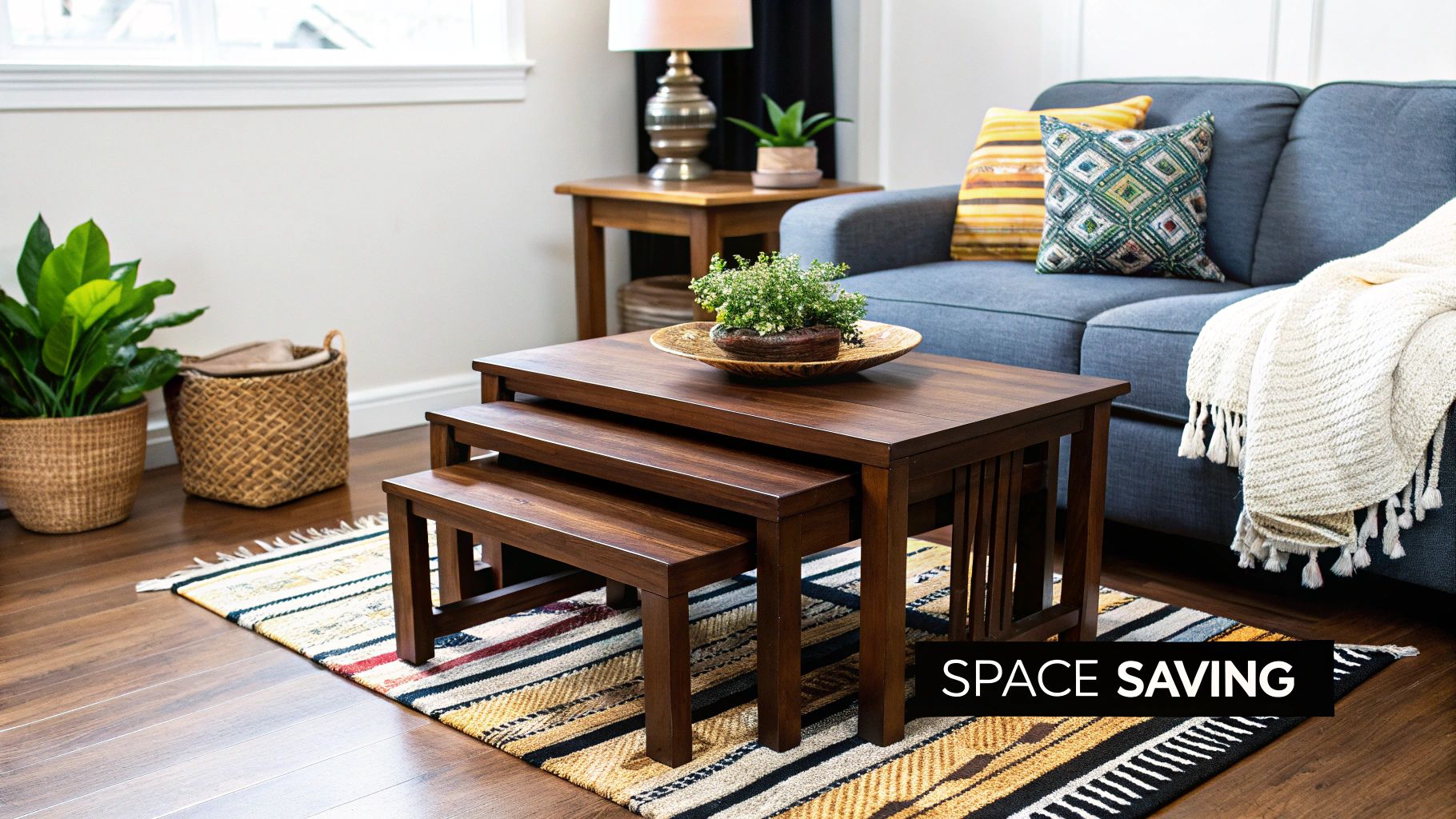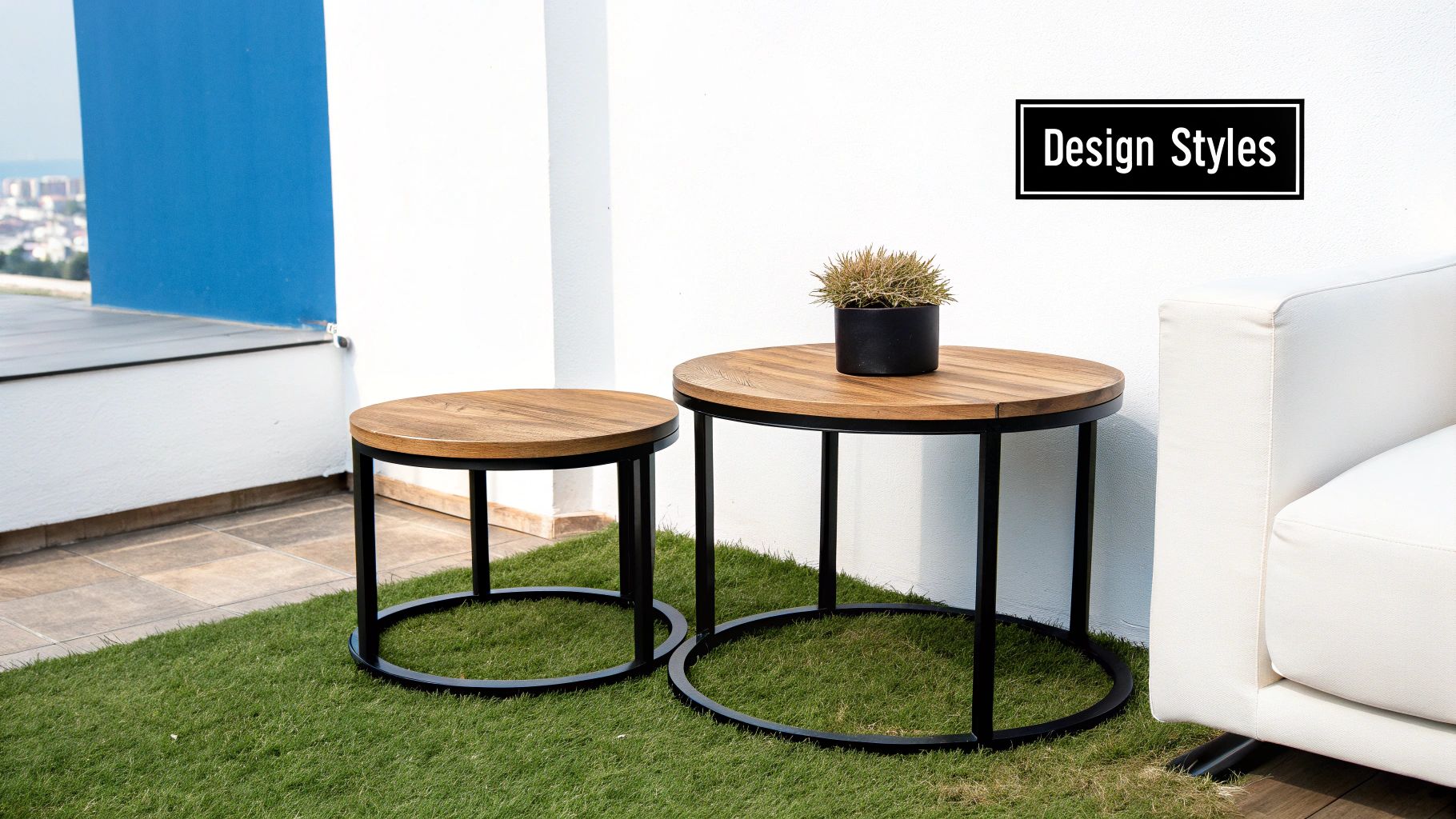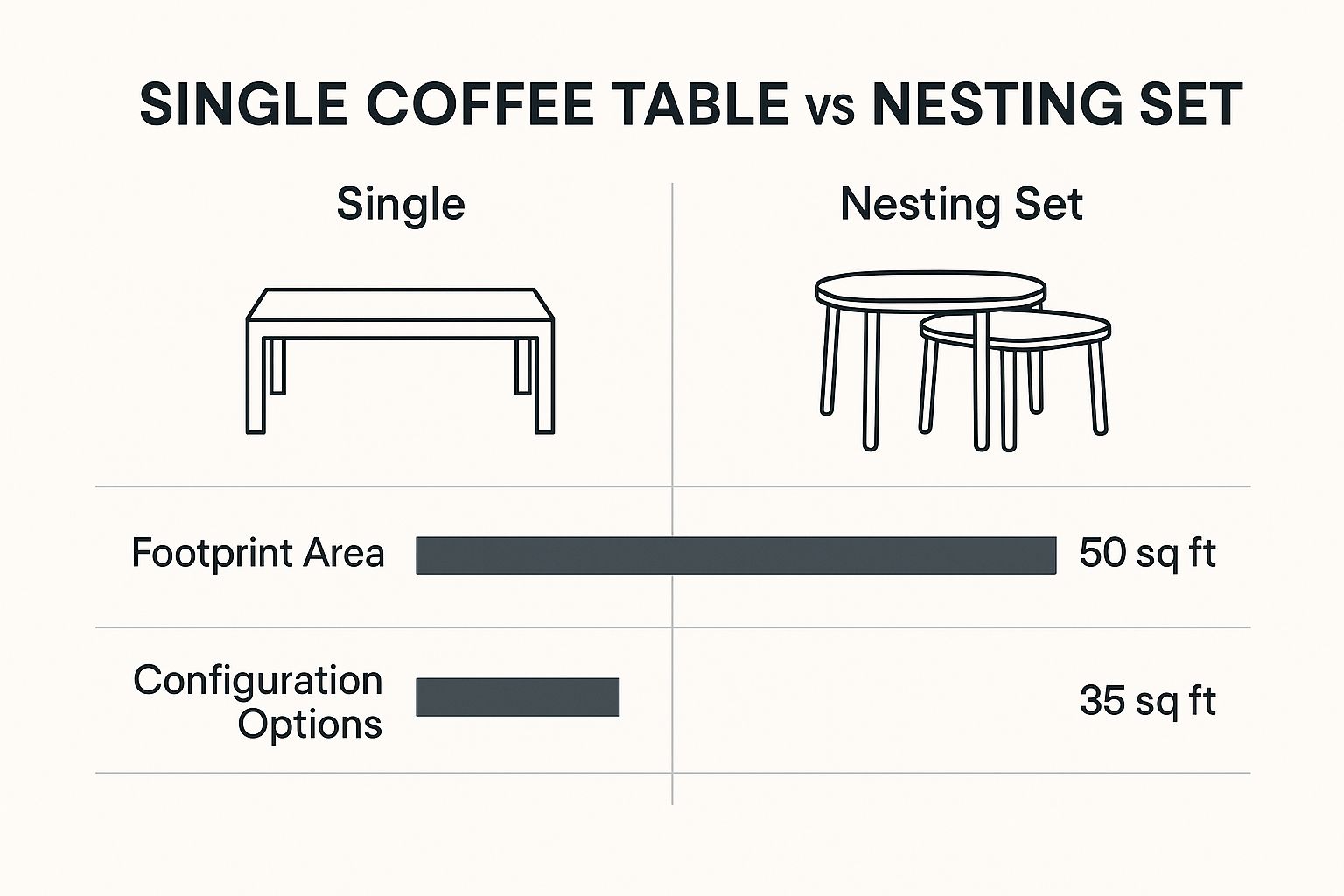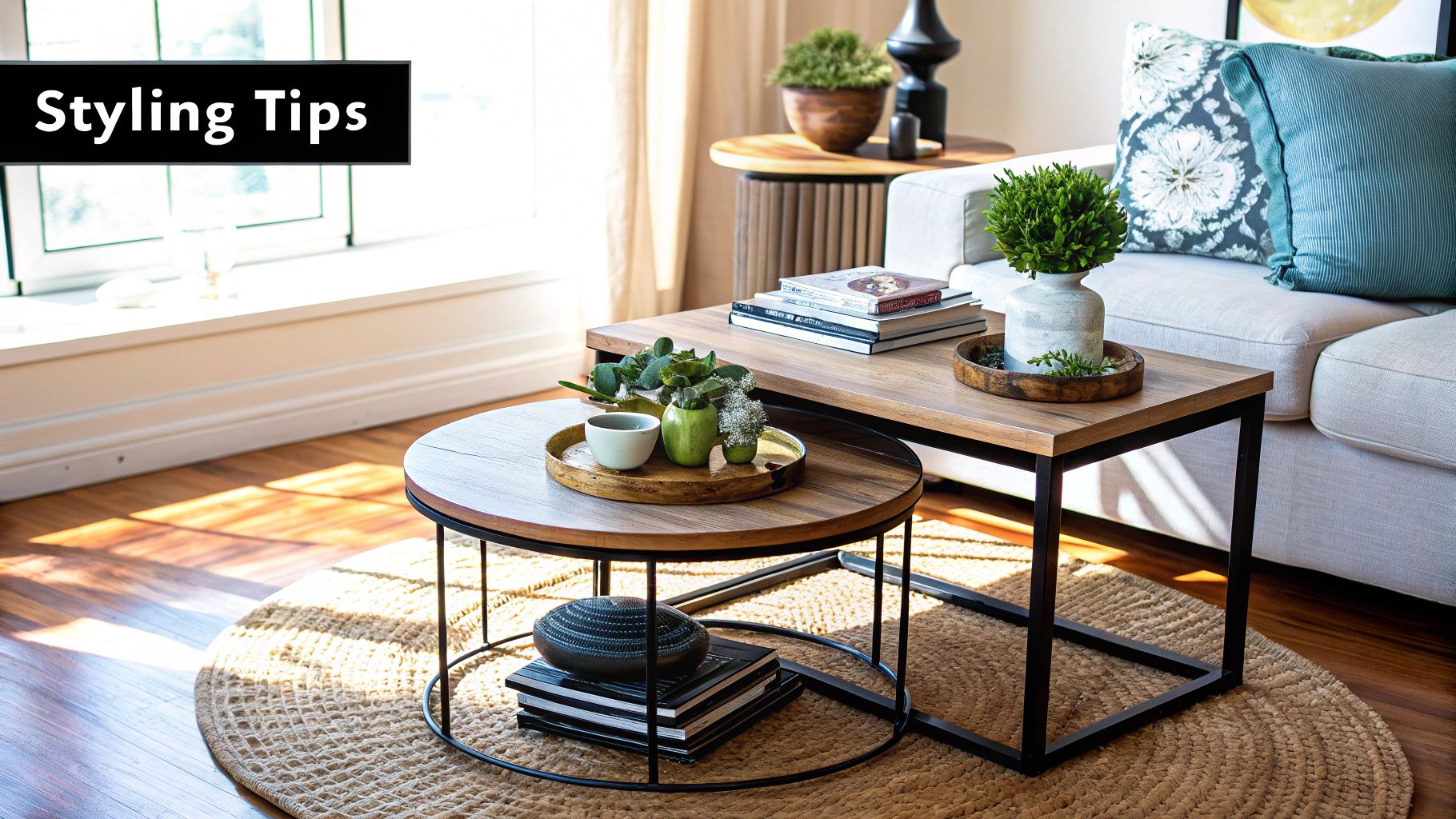You know those classic Russian nesting dolls? The ones where a smaller doll fits perfectly inside a larger one? That's the brilliant, simple idea behind a nesting coffee table. It's a set of two or more tables, each slightly smaller than the last, designed to tuck away neatly into a single, compact unit.
This design gives you multiple surfaces when you need them and a minimal footprint when you don't. It's a wonderfully practical concept that has become a staple in sophisticated interior design.
The Smart Solution for Modern Living
Let's be honest, space is often at a premium, especially in many of our modern New Zealand homes. We need furniture that not only looks stunning but also works hard for us. It has to be clever, adaptable, and genuinely useful. This is precisely where the nesting coffee table comes into its own. It’s not just one piece of furniture; it’s a dynamic system that expands and contracts with the rhythm of your life.
Picture this: you’re having friends over for a casual weekend get-together. With a simple pull, you can separate the tables, placing them strategically around the living room. Suddenly, everyone has a convenient spot for their drink or a plate of nibbles, creating a much more relaxed and sociable vibe. Once your guests have gone, the tables slide back together, and just like that, you’ve reclaimed your floor space. Your living room feels open and uncluttered again.
A Blend of Practicality and Style
This built-in flexibility solves so many common living room problems. A single, traditional coffee table can often feel like a compromise—either too big and bulky for the everyday, or too small when you're entertaining. A nesting set, however, gives you the best of both worlds.
- Adaptable Surface Area: Need a bit more room for your favourite art books, a vase of flowers, and your morning coffee? Just slide the tables apart. Craving a cleaner, more minimalist feel? Tuck them back together.
- Enhanced Functionality: Don’t just think of them as coffee tables. The smaller tables work beautifully as side tables next to an armchair or even as a temporary home for a lush pot plant or a statement lamp. Their versatility extends far beyond the centre of the room.
- Visual Interest: The different heights and often complementary materials create a layered, sophisticated look. This adds a wonderful sense of depth and character to your space that a single table just can't match.
We're seeing a real shift in what people want from their furniture. The living room furniture market in New Zealand is growing, largely because we’re all looking for pieces that blend style with clever functionality. As our living spaces become more thoughtfully designed, a nesting coffee table stands out as an elegant answer to a very modern need. For those interested in the numbers, you can explore more about these market trends and furniture demand in New Zealand.
A nesting coffee table is the ultimate chameleon. It can be a grand centrepiece for entertaining or a discreet accent for daily life, all while making your space feel larger, more organised, and effortlessly chic.
Ultimately, this single furniture choice solves multiple problems at once. It frees up both physical and visual space, gives you extra surfaces exactly when you need them, and introduces an element of curated, designer style. It’s a smart investment in a home that feels more flexible, beautiful, and wonderful to live in.
Exploring Materials from Marble to Mango Wood
The material you choose for your nesting coffee table does more than just hold your morning flat white; it sets the entire tone for your living space. It’s the visual anchor, the textural element, and the practical surface that has to stand up to daily life. Think of it like choosing the right coat for your wardrobe—some are built for timeless elegance, others for rugged durability, and some for a light, casual feel. The material tells your home’s story.

From the cool, veined luxury of marble to the organic warmth of rich mango wood, each option brings its own personality and set of practical considerations. Let's delve into the most popular materials to help you find the perfect match for your Kiwi home, aligning both your aesthetic vision and your lifestyle needs. This decision is about finding a beautiful balance between what you love to look at and what works for you every day.
Timeless Stone and Sophisticated Glass
Stone surfaces like marble and travertine are the epitome of luxury. They bring a sense of history, weight, and permanence to a room. A nesting coffee table with a marble top instantly elevates the space, its unique veining ensuring that no two pieces are exactly alike. This natural artistry pairs beautifully with contemporary luxe or minimalist decors, where the material itself becomes the focal point.
Travertine, with its warm, earthy tones and porous texture, offers a softer, more organic take on stone. It feels both ancient and modern, making it an incredibly versatile choice. However, these stunning materials do ask for a bit of care.
- Durability: Both are strong but can be porous. They are susceptible to stains from spills like red wine or coffee, and can chip if met with a heavy impact.
- Maintenance: Sealing is essential to protect against stains. Use coasters religiously and clean spills immediately with a pH-neutral cleaner.
- Best for: Homes aiming for a polished, high-end feel where a little extra care is part of the routine.
Glass, on the other hand, is the master of illusion. A glass-topped nesting coffee table is a brilliant solution for smaller living areas as it creates a sense of openness and light. By allowing you to see the floor beneath, it tricks the eye into perceiving more space, making the room feel larger and less cluttered. Often paired with sleek metal frames, glass tables are a hallmark of modern and industrial design.
Organic Warmth with Wood and Rattan
If stone brings drama, wood brings soul. Materials like mango wood, oak, and reclaimed timbers introduce an unmatched sense of warmth and organic texture. Mango wood, in particular, is celebrated for its beautiful grain variations—ranging from light golden browns to darker streaks—offering a visually rich surface that is both durable and sustainable.
A wooden nesting coffee table can ground a room, making it feel more inviting and lived-in. It’s a perfect fit for Scandinavian, coastal, or rustic interior themes that are so popular across New Zealand.
For a space to feel truly welcoming, it needs elements that connect to nature. Wood and rattan do this effortlessly, adding a layer of tactile warmth that polished surfaces can't replicate. They invite you to touch and engage with your furniture on a more personal level.
Rattan and other woven materials take this natural connection a step further. They bring a relaxed, bohemian vibe, ideal for creating a laid-back, coastal-inspired sanctuary. A rattan nesting table feels light and airy, adding texture without visual heaviness. It's the perfect piece for a sun-drenched lounge or a home that values casual, effortless style.
The Industrial Edge of Metal
Finally, metal brings an industrial, architectural quality to a nesting coffee table. Whether it’s a full metal design or simply the frame, materials like powder-coated steel, brass, or chrome make a strong statement. Blackened steel offers a raw, factory-inspired look, while polished brass or chrome can add a touch of glamour and sophistication.
Metal frames are most often paired with other materials—wood, glass, or marble tops—to create a balanced, dynamic look. This mix of materials is a key feature of contemporary design, allowing you to combine the sleekness of metal with the warmth or luxury of another element. This versatility makes a metal-framed nesting coffee table a truly adaptable choice for just about any modern home.
Finding the Perfect Size and Scale for Your Room
Choosing a nesting coffee table is about more than just finding a style you love; it’s about finding a set that feels like it truly belongs in your room. Getting the proportions right is the secret to creating a space that feels balanced and harmonious. It's a common mistake to see a table that's too big, crowding the space and making it hard to walk around, or one that’s too small, looking lost and insignificant, which throws the whole room off balance.

Think of it like getting a suit tailored. You're not just buying fabric; you're creating a perfect fit that complements your shape. Here, your "shape" is your living room and all the furniture already in it. By following a few key principles for measurement and clearance, you can choose a nesting set that doesn't just fit but actually improves your room’s flow and visual appeal.
The Crucial Height Relationship
Let's start with height. The relationship between your table and your sofa is the first thing to get right. If there’s an awkward height difference, using the table can feel clumsy, which is the last thing you want in a space designed for relaxation.
As a rule of thumb, the main coffee table should be no more than 10 cm higher or shorter than the top of your sofa's seat cushions. This little window of measurement ensures that reaching for a drink or a book feels completely natural. So, before you even start browsing, grab a measuring tape and get that sofa seat height—it’s the single most important number you’ll need.
Getting the Length and Proportions Right
Once you’ve got the height figured out, it’s time to think about length. This is where a real sense of scale comes into play. A tiny table in front of a huge, sprawling sofa will look comically small, while a massive table will completely dominate a more delicate loveseat.
Here’s a simple guideline that designers swear by: your main coffee table should be at least half, but no more than two-thirds, the length of your sofa. This creates a really pleasing visual balance, making sure the table is substantial enough to be useful without overpowering the entire seating area. If you have a sectional, just measure the main seating section, not the whole thing including the chaise.
A well-proportioned coffee table doesn't just look better; it feels better. It respects the room's architecture and the scale of the surrounding furniture, creating a sense of intentionality and calm.
This simple rule helps you sidestep the common pitfall of choosing a set that feels disconnected from its surroundings. Instead, it anchors your seating area, pulling everything together into a cohesive and inviting focal point.
Ensuring Ample Clearance for Flow
Finally, let’s talk about the space around the table. Your living room is for living in, which means you need to be able to move around comfortably. Nobody enjoys having to shimmy past furniture or stubbing a toe on their way to sit down.
The golden rule for clearance is to leave between 40 to 45 cm of space between the edge of your coffee table and your sofa. This is the sweet spot. It's close enough for convenience but provides enough room for easy foot traffic, giving the space a more open, uncluttered feeling. This measurement is also what will ultimately determine the maximum width or diameter your nesting table can be.
Here’s a quick checklist to take with you:
- Sofa Seat Height: Measure from the floor to the top of the seat cushion.
- Ideal Table Height: Your sofa seat height, plus or minus 10 cm.
- Sofa Length: Measure the main seating area of your sofa.
- Ideal Table Length: Between 1/2 and 2/3 of your sofa's length.
- Clearance Zone: Plan for 40-45 cm of open space around the table.
By taking these few simple measurements, you take all the guesswork out of the equation. You can confidently pick a beautiful nesting coffee table knowing it will fit your room with precision, making it both more beautiful and far more functional.
Mastering the Art of Styling Your Nesting Table
A beautifully styled nesting coffee table is far more than just a place to pop your cup. It’s the curated heart of your living room, transforming the space from merely functional to a genuine reflection of your personal style. Styling these multi-level pieces gives you a unique opportunity to create depth, texture, and a visual story, turning a simple piece of furniture into a captivating centrepiece.
The secret to achieving that designer look isn't about adding clutter; it's about thoughtful curation. It’s a delicate dance between beauty and practicality, ensuring the tables remain useful for daily life while still looking impeccably put-together. This balance is where the real art of styling lies.
Create Visual Interest with Triangulation
One of the most powerful principles in styling is triangulation. It’s a simple but incredibly effective technique. Just imagine an invisible triangle on your table’s surface—the corners are where you'll place your key decorative objects. This trick works exceptionally well on a nesting coffee table because you can create triangles on individual surfaces and across the different levels.
The trick is to vary the height of the items at each point. This simple variation forces the eye to move up, down, and across the display, creating a dynamic and engaging composition. A tall, elegant vase at one point, a medium-height stack of books at another, and a low decorative bowl at the third create a much more interesting view than three items of the same height.
- Tall Elements: Think slender vases with a few stems, a sculptural object, or a tall, elegant candle holder. These draw the eye upward.
- Medium Elements: A stack of two or three beautiful hardcover books, a scented candle in a jar, or a small potted plant fits perfectly here.
- Low Elements: Use a decorative tray, a small bowl for keys, or a beautiful coaster to anchor the arrangement.
This approach stops the display from looking flat and one-dimensional. When you play with different heights across the various table levels, you amplify the effect, creating a truly sophisticated and layered look that feels both intentional and effortless.
Use Trays to Organise and Define
A tray is an interior stylist's secret weapon. On a nesting coffee table, it serves a dual purpose: it corrals smaller items like remotes, coasters, and candles into a neat, contained display, and it adds another layer of texture and colour. Without a tray, these small objects can easily look like clutter, but grouping them together instantly makes them feel purposeful.
A well-chosen tray acts like a frame for your collection of small treasures. It provides structure and polish, turning a random assortment of items into a deliberate, cohesive vignette that enhances the overall aesthetic.
Choose a tray that complements your table’s material. A brass tray on a dark wood table adds a touch of glamour, while a marble tray on a glass surface introduces a sense of luxe weight. This simple addition makes your table look organised while keeping everyday essentials within easy reach. The impact of thoughtful styling shouldn't be underestimated, even in the property market. A Pāpāmoa Beach case study showed that styling a coffee table with curated accessories dramatically increased a property's online engagement and led to a faster sale at a higher price. Read the full success story to learn more about how styling impacts property value in NZ.
Bring Your Table to Life
Every styled surface needs a touch of life to feel vibrant and fresh. The easiest way to achieve this is by bringing in natural elements. A small vase of seasonal flowers, a few sculptural branches, or a hardy succulent can instantly soften the hard lines of your furniture.
These natural touches add colour, texture, and an organic shape that contrasts beautifully with any man-made objects in your arrangement. When choosing a plant, think about the scale of your table—a small, low-maintenance succulent or air plant works perfectly without overwhelming the space. This final layer bridges the gap between your home and the natural world, creating a room that feels both styled and truly alive. For more inspiration on creating beautiful arrangements, check out these inspiring table setting ideas for every occasion.
Matching Your Table to Your Interior Design Theme
A nesting coffee table shouldn't just be a piece of furniture you place in your living room; it should feel like it was always meant to be there. The key is to find a design that speaks the same visual language as the rest of your home, creating a cohesive look that feels both intentional and effortlessly stylish. Think of it as casting the final, perfect character in the story of your space.
By getting a feel for the signatures of different interior design themes, you can pick a table that blends in beautifully. Whether your home has the quiet calm of a minimalist retreat or the raw character of an industrial loft, there's a nesting table set that will complete the picture. It's less about strict rules and more about recognising the design cues that make a room feel complete.
Scandinavian and Japandi Serenity
For homes that embrace light, simplicity, and natural textures, your coffee table should follow suit. The Scandinavian aesthetic, known for its clean functionality and love of nature, pairs perfectly with tables crafted from light-hued woods like oak or ash. Look for simple forms and slender, often tapered legs that give the furniture an airy, floating quality.
Japandi design, that beautiful blend of Japanese minimalism and Scandi function, takes this concept even further. It celebrates the 'perfectly imperfect' and values the soul of handcrafted pieces.
- Materials to look for: Pale timbers are your best friend here—think white oak, ash, or light maple. A touch of matte black metal in the frame can add a lovely, grounding contrast without being overbearing.
- Key features: Stick to simple, organic shapes. Softly rounded rectangles or pure circles are ideal. The beauty is in the absence of fussy details, letting the pure, functional design shine through.
The goal is to choose a set that enhances the room's tranquil, harmonious atmosphere, not disrupts it.
A nesting table in a minimalist setting is more than just furniture; it's a quiet statement. Its layered forms add subtle dimension without disrupting the room's serene atmosphere, proving that functional design can also be deeply peaceful.
Industrial and Urban Edge
If your space is all about celebrating raw materials and architectural bones, an industrial-style nesting coffee table will feel right at home. This look takes its cues from old factories and warehouses, putting honest, hardworking materials like distressed wood and raw metal front and centre.
An industrial nesting table often creates a powerful play of textures. You can’t go wrong with a classic combination like a chunky, reclaimed wood top set on a dark, powder-coated steel frame. The charm is in the imperfections—the unique grain of the wood, the subtle texture of the metal—that give the piece a sense of history and character. For a bit of inspiration, check out these Top Coffee Shop Design Ideas; cafés often nail this aesthetic, blending industrial elements into chic, urban spaces.

Mid-Century Modern Charm
The Mid-Century Modern (MCM) style is all about optimism, clean lines, and iconic shapes. A nesting table that captures this vibe will often feature those classic organic, kidney-bean forms or simple, nested circles. Tapered, splayed legs are an absolute hallmark of the era, giving furniture a distinctive, almost energetic stance.
Warm woods like teak and walnut are the heart of the MCM palette, often paired with other materials for a bit of playful contrast. When you're curating a truly luxurious space, every detail counts, from the furniture right down to the windows. You can explore how to extend this thoughtful design to other parts of your home with our guide on luxury window treatment ideas for NZ homes.
To help you visualise which table might work best, here’s a quick guide matching different nesting table styles to popular interior themes.
Nesting Table Styles vs. Interior Themes
| Interior Design Style | Recommended Materials | Typical Shapes |
|---|---|---|
| Scandinavian / Japandi | Light woods (oak, ash), matte black metal | Simple circles, rounded rectangles, organic forms |
| Industrial / Urban | Reclaimed wood, raw steel, concrete, dark metals | Strong squares, rectangles, mixed geometric shapes |
| Mid-Century Modern | Teak, walnut, glass, brass accents | Kidney-bean, abstract organic, simple circles |
| Glam / Art Deco | Marble, polished brass/gold, mirrored glass, velvet | Geometric hexagons, nested circles, layered ovals |
| Modern Farmhouse | Distressed or painted wood, wrought iron | Chunky rectangles, simple round sets |
| Coastal / Hamptons | Whitewashed wood, rattan, woven textures | Round or square with natural, airy feel |
Choosing the right material and shape is the secret to making your nesting tables look like a deliberate, integrated part of your design rather than an afterthought. Use this as a starting point to find a set that not only fits your space but elevates it.
Why Nesting Tables Are a Perfect Fit for the Modern Kiwi Home
Here in New Zealand, our homes are more than just four walls and a roof—they're the heart of our social lives, spaces for connection, relaxation, and countless conversations. Our lifestyle is all about casual get-togethers and a genuine appreciation for a good flat white, so our furniture needs to be just as flexible and welcoming as we are. That’s precisely why the nesting coffee table isn't just a trend; it's a piece that truly gets the Kiwi way of life.

Picture this: you've got friends coming over for a weekend catch-up. With a nesting set, you can effortlessly glide the smaller tables out to create instant new spots for drinks, cheese platters, and snacks. Suddenly, your living room is a more interactive and comfortable hub, fostering that relaxed, easy-going atmosphere we all love.
Then, once the last guest heads home, the tables slide neatly back together. Just like that, you’ve reclaimed your floor space, and the room feels open and uncluttered again. It’s this smart adaptability that makes nesting tables such a practical partner for the natural rhythm of our social lives.
An Ode to Our Coffee Culture
Let's be honest, Kiwis are serious about their coffee. It's a passion that goes far beyond the local café and right into our homes, shaping the very way we design our living spaces. We love creating little nooks and settings that celebrate the daily ritual of brewing and savouring a quality cuppa.
This deep appreciation for coffee culture plays a big part in our furniture choices. A stylish coffee table is more than just furniture; it’s the centrepiece for this daily ceremony. The nesting table, with its adaptable surfaces, beautifully supports this passion, offering the perfect platform whether you're enjoying a quiet morning brew or serving coffee to friends.
A nesting coffee table is the ultimate host. It expands to welcome company and contracts for quiet moments, all while providing the perfect stage for our cherished coffee rituals. It's furniture that understands the flow of a modern Kiwi household.
The Ultimate in Versatility
The real magic of a nesting set is its incredible versatility—something that really speaks to our practical Kiwi mindset. These individual tables aren't just confined to the living room.
- A Handy Side Table: Need a spot for your book and a cup of tea? Pull out a smaller table and place it next to your favourite armchair.
- A Creative Display: Use one of the tables as a chic plant stand in a sunny corner to bring a touch of green indoors.
- Flexible Function: In a pinch, a smaller table can even step in as a temporary bedside table in a guest room. For more tips on making your spaces feel inviting, explore our guide to creating a cosy bedroom sanctuary.
This ability to wear multiple hats makes the nesting coffee table an incredibly smart choice for any home. It’s a hardworking piece that adapts to your life, enhancing your space without ever compromising on style.
A Few Common Questions
When you're considering nesting coffee tables, a few questions almost always pop up. Getting these sorted can make all the difference, helping you choose a set that doesn't just look stunning but also fits perfectly with how you live. We've put together some of the most common queries to give you a bit more clarity.
Are Nesting Coffee Tables Still in Style?
Absolutely. Nesting coffee tables are far more than just a passing trend; they’re a staple in the interior design world for a reason. They beautifully blend elegant form with smart function.
Their natural versatility and space-saving design make them a perfect fit for contemporary living, where furniture that can adapt is always a winner. Designers are constantly giving them a fresh spin with new materials, unexpected shapes, and unique textures. This ongoing reinvention means they feel right at home in any setting, from stark minimalism to eclectic maximalism, solidifying their spot as a truly timeless choice.
The real genius of a nesting table is its cleverness. It solves a common problem—the need for flexible surfaces—while adding a dynamic, layered look that a single table just can't offer. It’s a classic idea that just keeps getting better.
How Do I Stop My Nesting Tables From Scratching Each Other?
It's actually quite simple to keep your tables looking pristine. To prevent scratches, especially on timber, metal, or painted finishes, just stick small, clear felt or silicone pads on the underside of the smaller tables. Place them where they’re most likely to touch the larger table's surface or legs.
You can find these pads at any local hardware store here in New Zealand; they're inexpensive and practically invisible. While many high-quality sets are designed with a built-in clearance to avoid this issue, adding pads gives you that extra peace of mind and helps them glide smoothly without any friction.
Can I Use the Nested Tables in Different Rooms?
Yes, and that’s one of the best things about them! While they're designed to look beautiful together, each table is a standalone piece. This incredible flexibility lets you change up your space whenever the mood or need strikes.
For instance, you could:
- Keep the largest table in the living room as your main coffee table.
- Tuck a smaller one beside an armchair to hold a good book and a cuppa.
- Place another in a sunny corner as a stylish plant stand, or even use it as a makeshift bedside table in the guest room.
This ability to be split up and repurposed adds so much value, ensuring you get maximum use from your furniture.
Ready to find the perfect piece to anchor your living space? At The Foxes Den, we believe in timeless design and artisanal quality. Explore our curated collection of luxury homewares and discover the nesting coffee table that will truly elevate your home. Find your next statement piece at The Foxes Den.


